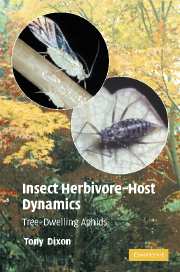Book contents
- Frontmatter
- Contents
- Preface
- 1 Introduction
- 2 Tree-dwelling aphids
- 3 Trees as a habitat: relations of aphids to trees
- 4 Trees as a habitat: relations of aphids to their natural enemies
- 5 Carrying capacity of trees
- 6 Aphid abundance
- 7 Population dynamics
- 8 Risky dispersal
- 9 Seasonal sex allocation
- 10 Aphids and tree fitness
- 11 Rarity, conservation and global warming
- Epilogue
- References
- Species index
- Subject index
9 - Seasonal sex allocation
Published online by Cambridge University Press: 08 August 2009
- Frontmatter
- Contents
- Preface
- 1 Introduction
- 2 Tree-dwelling aphids
- 3 Trees as a habitat: relations of aphids to trees
- 4 Trees as a habitat: relations of aphids to their natural enemies
- 5 Carrying capacity of trees
- 6 Aphid abundance
- 7 Population dynamics
- 8 Risky dispersal
- 9 Seasonal sex allocation
- 10 Aphids and tree fitness
- 11 Rarity, conservation and global warming
- Epilogue
- References
- Species index
- Subject index
Summary
Most tree-dwelling aphids have an holocyclic life cycle, in which there is a series of parthenogenetic generations culminating in the production of males and sexual females, which lay the eggs. In temperate regions egg-laying coincides with the onset of winter, but in other parts of the world it coincides with the onset of a hot/dry season. The switch to sex should be postponed as long as possible as it ends the phase of rapid parthenogenetic reproduction. However, mating and oviposition must occur before the end of the favourable season, which for aphids living on deciduous trees in temperate regions is leaf fall. In the sycamore aphid the production of sexual females is cued mainly by short day-length and low temperature (Dixon, 1971d). That is, in common with other aphids, it shows environmental sex determination. In terms of physiology it is likely that environmental cues trigger neuroendocrine changes in the aphid, which control the sex of its offspring at the time of the maturation division of the ova. The result is that the males and females are present for a relatively short period in autumn at a time when population abundance is changing very rapidly (Figure 9.1). That is, both sexes make only a brief appearance and neither achieve an equilibrium density. In addition, the fitness of a male depends on the number of females it fertilizes, while that of a female depends on her probability of mating.
- Type
- Chapter
- Information
- Insect Herbivore-Host DynamicsTree-Dwelling Aphids, pp. 136 - 146Publisher: Cambridge University PressPrint publication year: 2005



